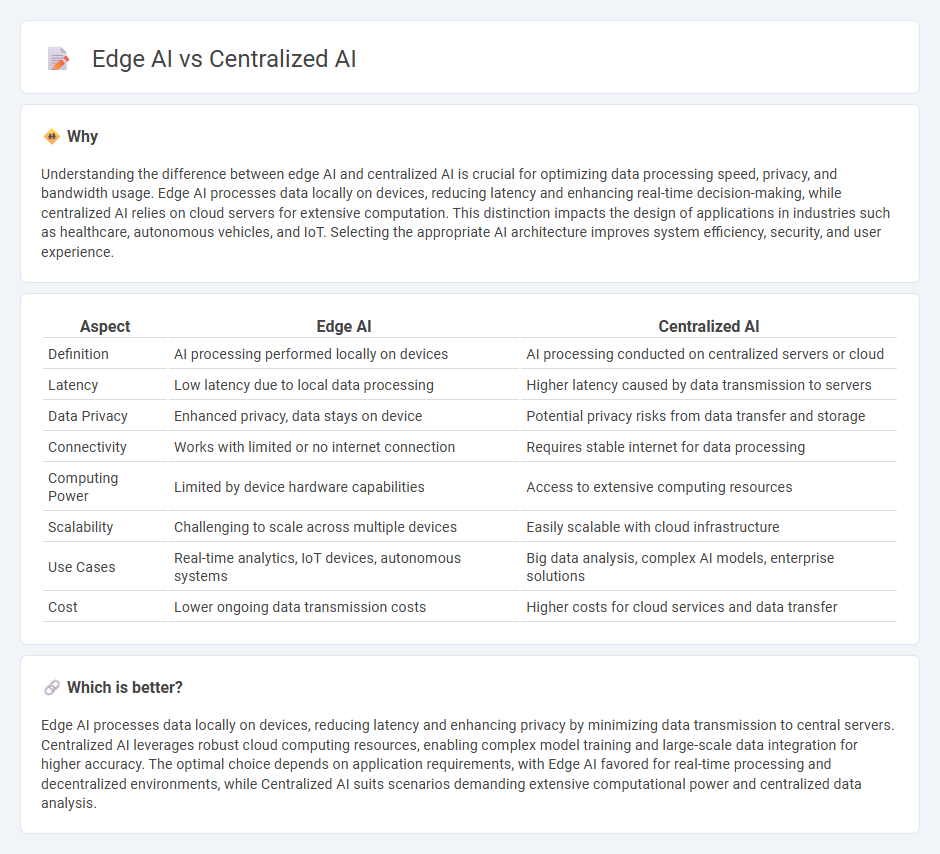
Edge AI processes data locally on devices, enabling faster decision-making and enhanced privacy by minimizing data transfer to central servers. Centralized AI relies on powerful cloud-based systems to analyze vast datasets, offering high accuracy but often facing latency and security challenges. Explore the differences between Edge AI and centralized AI to understand their impact on modern technology.
Why it is important
Understanding the difference between edge AI and centralized AI is crucial for optimizing data processing speed, privacy, and bandwidth usage. Edge AI processes data locally on devices, reducing latency and enhancing real-time decision-making, while centralized AI relies on cloud servers for extensive computation. This distinction impacts the design of applications in industries such as healthcare, autonomous vehicles, and IoT. Selecting the appropriate AI architecture improves system efficiency, security, and user experience.
Comparison Table
| Aspect | Edge AI | Centralized AI |
|---|---|---|
| Definition | AI processing performed locally on devices | AI processing conducted on centralized servers or cloud |
| Latency | Low latency due to local data processing | Higher latency caused by data transmission to servers |
| Data Privacy | Enhanced privacy, data stays on device | Potential privacy risks from data transfer and storage |
| Connectivity | Works with limited or no internet connection | Requires stable internet for data processing |
| Computing Power | Limited by device hardware capabilities | Access to extensive computing resources |
| Scalability | Challenging to scale across multiple devices | Easily scalable with cloud infrastructure |
| Use Cases | Real-time analytics, IoT devices, autonomous systems | Big data analysis, complex AI models, enterprise solutions |
| Cost | Lower ongoing data transmission costs | Higher costs for cloud services and data transfer |
Which is better?
Edge AI processes data locally on devices, reducing latency and enhancing privacy by minimizing data transmission to central servers. Centralized AI leverages robust cloud computing resources, enabling complex model training and large-scale data integration for higher accuracy. The optimal choice depends on application requirements, with Edge AI favored for real-time processing and decentralized environments, while Centralized AI suits scenarios demanding extensive computational power and centralized data analysis.
Connection
Edge AI processes data locally on devices, reducing latency and enhancing real-time decision-making, while centralized AI aggregates and analyzes large datasets on cloud servers for comprehensive insights. These two AI paradigms collaborate by sharing processed data from edge devices to central systems, enabling efficient, scalable learning and improved model accuracy. The synergy between edge AI's immediate responsiveness and centralized AI's deep learning capabilities drives advanced applications in industries such as autonomous driving and smart cities.
Key Terms
Data Processing Location
Centralized AI processes data in a centralized data center or cloud, enabling extensive computational power and better scalability but often facing latency and privacy challenges due to data transmission. Edge AI performs data processing locally on IoT devices or edge servers, reducing latency, enhancing real-time decision-making, and improving data security by minimizing data sent to the cloud. Explore the detailed trade-offs and use cases between centralized and edge AI to optimize your data strategy.
Latency
Centralized AI processes data in remote data centers, resulting in higher latency due to transmission delays, especially in time-sensitive applications. Edge AI performs inference locally on devices like smartphones or sensors, significantly reducing latency and enabling real-time responsiveness. Explore the advantages of latency improvements with edge AI to enhance your system's performance.
Privacy
Centralized AI processes data on remote servers, which can raise concerns about data privacy and potential breaches during transmission or storage. Edge AI processes data locally on devices, significantly reducing the risk of sensitive information exposure and enhancing user privacy. Discover how leveraging edge AI can transform your privacy strategy and secure your data more effectively.
Source and External Links
What is the Difference Between Centralized and Decentralized AI? - Centralized AI dominates today's AI landscape, enabling efficient processing of massive datasets but creating risks such as data monopolies, single points of failure, and concentrated power, in contrast to decentralized AI which distributes compute, data control, and governance across many participants for greater resilience, privacy potential, and democratized innovation.
Decentralized AI: A Transparent and Ethical Alternative to "Black Boxes" - Centralized AI models function as opaque black boxes raising concerns around transparency, ethics, and accountability, whereas decentralized AI leverages blockchain technology and open-source protocols to enhance transparency, reduce bias, ensure ethical data usage, and enable regulatory oversight.
Centralizing or Decentralizing Generative AI? The Answer: Both - AWS - Centralized AI offers governance, scalability, and compliance benefits, while decentralization enables domain-specific innovation; combining both approaches allows enterprises to balance control with agility, centralizing core infrastructure and decentralizing application development for the best outcomes in generative AI adoption.
 dowidth.com
dowidth.com